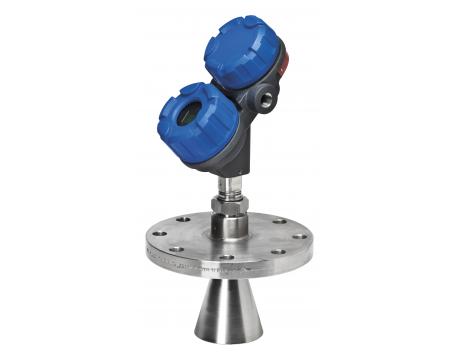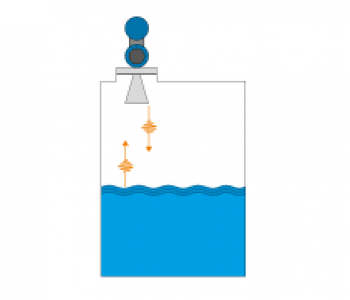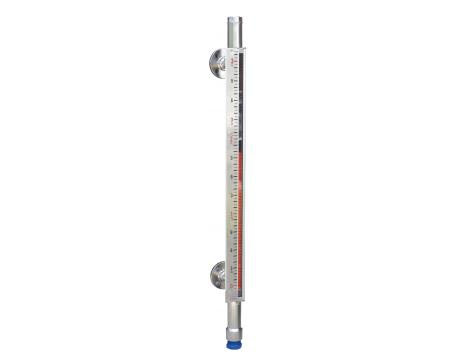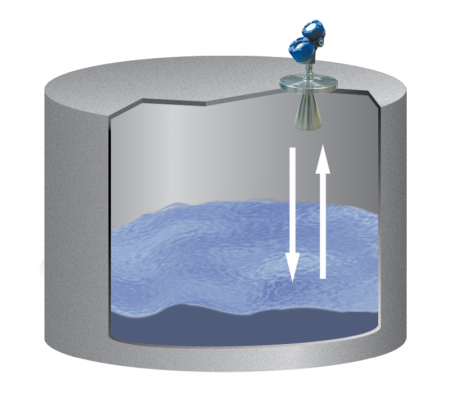
The Pulsar® Model R96 is a loop-powered, 24 VDC, non-contact radar level transmitter. It has a longer measurement range, improved diagnostics and is easier to use than most loop-powered radar transmitters.

The Pulsar® Model R96 is a loop-powered, 24 VDC, non-contact radar level transmitter. It has a longer measurement range, improved diagnostics and is easier to use than most loop-powered radar transmitters.

Pulse Burst Radar emits short bursts of energy to a liquid surface. Ultra-high-speed timing circuitry measures the time of the signal reflected off the liquid surface.
Sophisticated signal processing filters out false reflections and other background noises. The exact level is then calculated, by factoring in tank height and other configuration information. The circuitry is extremely energy efficient so no duty cycling is needed as with other radar devices. This allows the device to track high rates of level changes up to 4,5 m/minute (180″/min).
Options
 Horn antennas
Horn antennasPulse burst radar horn antennas are a robust and electromagnetically efficient design that offers the highest level of performance in typical through-air radar applications. The largest horn antenna should be used to ensure the best possible performance in all operational conditions.
For a large number of pulse burst radar installations that require 6 GHz operation where an existing process connection will not accommodate a horn antenna, Magnetrol offers a dielectric rod antenna. Typically constructed of 316SS and TFE or polypropylene, additional materials are also available.
 PULSAR transmitter technology is based on pulse-burst radar technology together with equivalent time sampling circuitry. Short bursts of 6 GHz microwave energy are emitted and subsequently reflected from the liquid level surface.
PULSAR transmitter technology is based on pulse-burst radar technology together with equivalent time sampling circuitry. Short bursts of 6 GHz microwave energy are emitted and subsequently reflected from the liquid level surface.
| ATEX | Ex d, Ex ia, Ex n |
|---|---|
| CSA | XP, IS, NI |
| FM | XP, IS, NI |
| EAC (GOST) | Ex d, Ex ia, Metrology |
| IEC | Ex d, Ex ia |
| SIL | SIL 2 (1oo1) |
Other approvals are available.
Options
 Horn antennas
Horn antennasPulse burst radar horn antennas are a robust and electromagnetically efficient design that offers the highest level of performance in typical through-air radar applications. The largest horn antenna should be used to ensure the best possible performance in all operational conditions.
For a large number of pulse burst radar installations that require 6 GHz operation where an existing process connection will not accommodate a horn antenna, Magnetrol offers a dielectric rod antenna. Typically constructed of 316SS and TFE or polypropylene, additional materials are also available.
 PULSAR transmitter technology is based on pulse-burst radar technology together with equivalent time sampling circuitry. Short bursts of 6 GHz microwave energy are emitted and subsequently reflected from the liquid level surface.
PULSAR transmitter technology is based on pulse-burst radar technology together with equivalent time sampling circuitry. Short bursts of 6 GHz microwave energy are emitted and subsequently reflected from the liquid level surface.
| ATEX | Ex d, Ex ia, Ex n |
|---|---|
| CSA | XP, IS, NI |
| FM | XP, IS, NI |
| EAC (GOST) | Ex d, Ex ia, Metrology |
| IEC | Ex d, Ex ia |
| SIL | SIL 2 (1oo1) |
Other approvals are available.